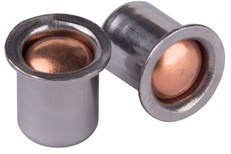The Basic Principles Of Winchester Primers
Wiki Article
The Single Strategy To Use For Primers In Stock
Table of ContentsThe Main Principles Of Winchester Primers The Buzz on Winchester PrimersAll about Cci PrimersFederal Primers - An OverviewNot known Facts About Reloading Primers
Component of the firearm cartridge for initiating propellant combustion In guns and artillery, the guide () is the chemical and/or gadget liable for initiating the propellant burning that will certainly press the projectiles out of the weapon barrel. In early black powder guns such as muzzleloaders, the guide was basically the exact same chemical as the primary propellant (albeit normally in a finer-powdered type), however poured into an external flash frying pan, where maybe sparked by an ignition resource such as a slow-moving match or a flintlock Some muzzleloaders have guides like cap gun caps.
In weapons the primers are frequently a separate component, put inside the barrel to the back of the major propellant chargebut there are other instances of weapons, consisting of for example some automated weapons, created to fire cartridges with integral electric primers.
More About Reloading Primers

With the advent of hand-held guns, this came to be an unwanted way of shooting a weapon. Holding a burning stick while trying to pour a cost of black powder carefully down a barrel is unsafe, and also trying to hold the weapon with one hand while at the same time intending at the target and looking for the touchhole makes it extremely tough to fire precisely. The very first attempt to make the process of firing a little arm less complicated was the "matchlock".
, as well as dried. After the weapon was filled and also the touchhole primed with powder, the burning pointer of the match was positioned so that the lock would bring it right into contact with the touchhole.
The Only Guide to Rifle Primers
This brought the suit to the touchhole, firing up the powder. With cautious attention, the slow-burning match could be maintained burning for lengthy periods of time, and making use of the lock system made relatively precise fire possible. The following revolution in ignition innovation was the "wheel-lock". It made use of a spring-loaded, serrated wheel which rubbed versus a piece of iron pyrite, similar to a modern-day lighter.

The covered flashpan likewise gave some ability to endure poor climate. The wheel-lock enjoyed just a short duration of popularity before being superseded by an easier, extra robust design.
The Only Guide for Remington Primers
As the name suggests, the flintlock made use of flint as opposed to iron pyrite. The flint was held in a spring-loaded arm, called the "penis" from the similarity of its activity to here are the findings a pecking hen. The cock revolved with approximately a 90-degree arc as well as was held in the tensioned, or "cocked" position by a trigger. https://www.corpsubmit.com/author/relodprim3rs/.The "half-cock" setting held the dick midway back, as well as utilized a deep notch to make sure that shooting would not release the penis. Half-cock was a safety and security position, utilized when loading, keeping or lugging a crammed flintlock. The "full-cock" placement held the dick right back and was the placement where the gun was discharged.
It offered as both a flashpan cover as well as a steel striking surface area for the flint. The frizzen was hinged and also spring-loaded to ensure that it would certainly secure in the open or closed placement. When closed, the striking surface was placed to make sure that the flint would strike at the appropriate angle to produce a stimulate.
The Definitive Guide for Primers In Stock
The flintlock device was easier as well as stronger than the wheel-lock, and the flint and steel provided an excellent, trusted source of ignition. The flintlock remained in armed forces service for over 200 years, as well as flintlocks are still made today for historic re-enactments and muzzle-loading target competitors, and for hunters who delight in the additional challenge that the flintlock supplies.Percussion ignition was designed by Scottish clergyman Rev. Alexander John Forsyth in 1807 yet needed better refinements prior to it was slowly approved in the 1820s to 1830s. By the center of the 19th century, the percussion or caplock system was well developed. It was taken on by both sides in the American Civil War, as it was simpler as well as more reliable than the flintlock.
The flashpan and also frizzen were removed and changed by a little, hollow horizontal cyndrical tube (drum) screwed into the bored-out as well as tapped flash opening and lugging a "nipple" over which the cap can be fitted. A "hammer" which also had half-cock (for loading and also applying the cap) and full-cock positions replaced the penis.
Report this wiki page